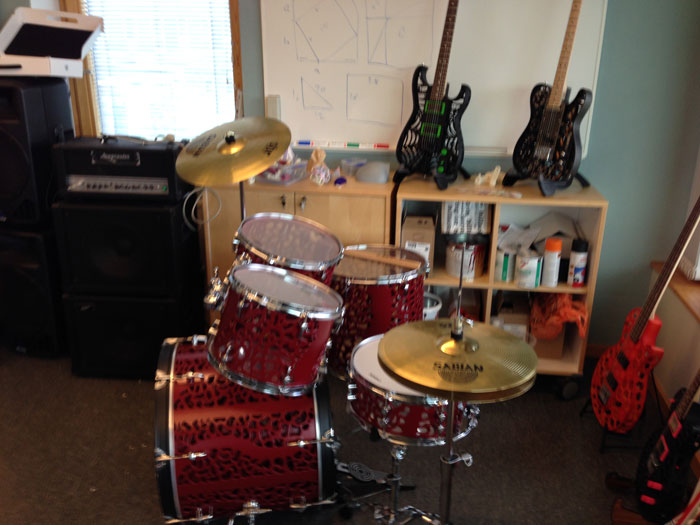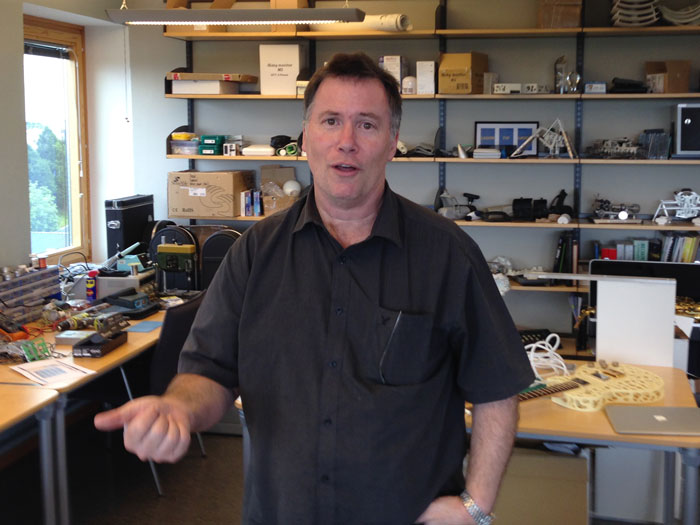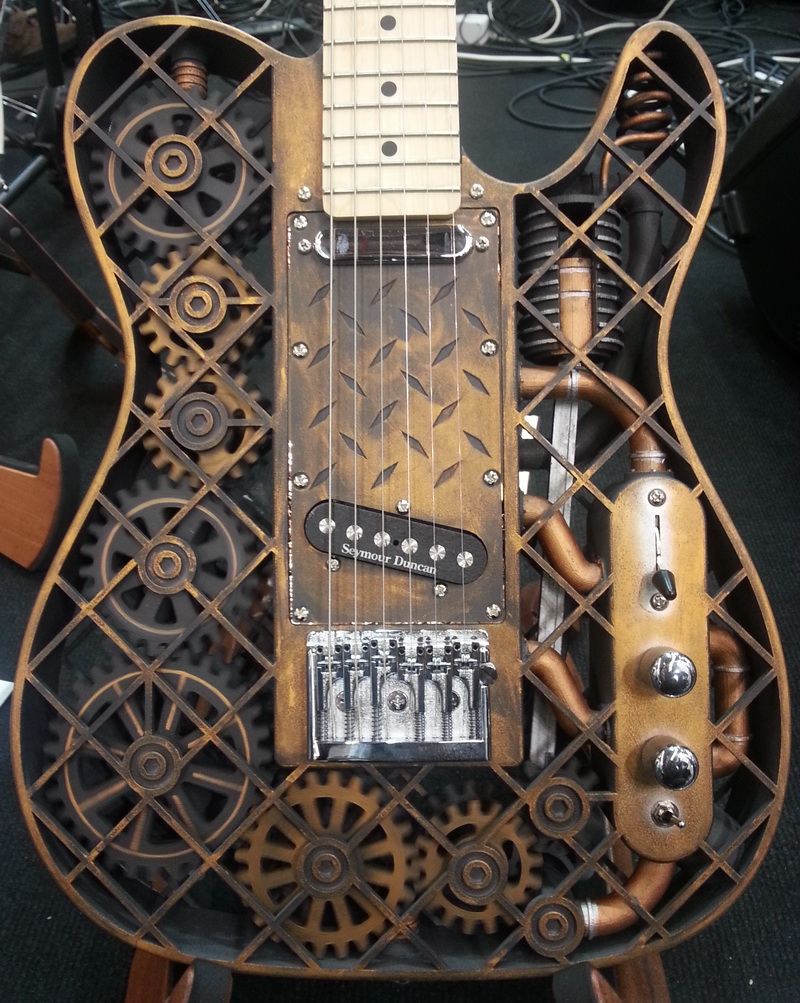 A couple of days ago I met mr. Olaf Diegel, the new professor in Machine Design, at Department of Design Sciences, Faculty of Engineering LTH at Lund University in Sweden.
A couple of days ago I met mr. Olaf Diegel, the new professor in Machine Design, at Department of Design Sciences, Faculty of Engineering LTH at Lund University in Sweden.
With only three months in Sweden there is still much to figure out for a professor – not only the difficult Swedish language. But here we have a real global guy: born in New Zeeland by Swiss parents, educated in the French part of Canada, in Australia and in South Africa, and who which also have worked as teacher in Japan! Global thinking – I presume. Then you can see in the pictures how it must look like in a product development professors room. 😀
What is product development for you?
– If I have to define it, it will be: ”adding value to the customer”. Then I can’t ignore the impact and the fact of 3D printing! It’s nearly like Gutenberg’s print evolution 600 years ago. When you can use a 3D printer to instantly produce the idea AND test it, the product development process shortens by half! This for example reduce cost, time needed and functionality tests. Or in other words: faster, cheaper and more sufficient!
Give your view of product development during the past 20-30 years?
– My insight and knowledge says that for 20 years ago the market decided the process, and the consumer was out of ”concern”. Today the consumer is invited to be a part of the product development process, and in the future the product development process will be even more consumer driven!
More consumer driven? – I suppose you mean that the end-consumer today have more possibilities to over-view the process, and thereby can both influence and ”run” the product development process?
– Yes, exactly!
How will you best manage the product development process, according to your experience?
– Yesterday and today most processes are linear. I.e. first A then B and then C. The best way is to do A, B and C simultaneously. BUT after a while this simultaneous process went linear, and we are back to zero!
Which is the most efficient product development process?
– The best product development process is when all is made parallel all at once (these project that can be made this way – all can’t), but when you write this very process down, in a book or paper, it turns linear! That‘s the dilemma.
You are an engineer and had worked which several different competences during your carrier. How will you build the best product development team?
– Engineers are educated the same linear way, and thereby think the same linear way. So to build the best team needs several different competences, educated as well as street-smart competences. When you have five equal (education, gender, socioeconomic status etc) persons, you have the linear problem right away from start. And this is not positive concerning the development process.
Another way to see it is that the non-trained engineer asks: way can’t we do like this? And the trained engineer rejects the idea direct, according to his/her educational knowledge.
 Mention a product or process that have inspired you within product development, and why?
Mention a product or process that have inspired you within product development, and why?
– 3D printing! It makes us test the new idea directs…which generate easier, cheaper and faster products into the market.
Artist, engineers, designers etc. understand the 3D printing, so it has become a catalyst for the product development process where all competences can meet and work together, and the all contribute.
A good example is when a couple of artist worked side by side with some engineers in contemporary art project. Before the artists had gone to the engineer and ask: can this be done? and the engineer had said Now, it’s impossible. Here the worked side by side, and solve the problems together.
Then another twist is that the children have drifted away to the digital world, but are getting back to the physical via 3D printing! When children see the outcome, he/she instant knows what to do.
Can you say a person that have inspired you in the product development area, and why?
 – Ray Avery. And this for his philosophy product realisation idea, or rather ”idea realisation”: the idea is worthless unless you not turn them into something valuable for the society. He worked for Medicine Mondiale with the cataract problem in Asia, and his ”idea realisation lens” have changed the situation for both individuals and the society, by reduce the cost from hundreds of dollars per substitution lens to only cost $1 or $2!
In his case it was to help developing countries not to make money, but it show the ”idea realisation” in a nutshell.
– Ray Avery. And this for his philosophy product realisation idea, or rather ”idea realisation”: the idea is worthless unless you not turn them into something valuable for the society. He worked for Medicine Mondiale with the cataract problem in Asia, and his ”idea realisation lens” have changed the situation for both individuals and the society, by reduce the cost from hundreds of dollars per substitution lens to only cost $1 or $2!
In his case it was to help developing countries not to make money, but it show the ”idea realisation” in a nutshell.
”Idea Realisation” – is this the new word for product development that better fit our contemporary society?
– Yes, to me this is more meaningful and more abstract. This is why I love 3D printing that much – it’s perfect for realising an idea instantly, and I can guarantee that 80% of the ideas are stupid, so you can eliminate them direct.
You have lived in several parts of the world, so can you describe the similarities and differences in product development around the world?
– I will say that there is not so much differences between countries or national cultures. The difference is between small or large corporations. The larger corporation, the harder to succeed, or in other words, the bureaucracy rules there.
In New Zeeland most organisations are micro organisations with one or two persons, and the have limited resources in all aspects. Therefore the need to improvise more and take instant decisions. So there is an incorporated need for solving the problem fast, which make an iterative process. This is one explanation why the product development process is more effective in smaller organisations.
Another thing, when arriving to Sweden I went surprised that the Swedish 3D scene, you are behind US, Europe and even New Zeeland! Compare this with the reputation Sweden got as a leader in design and innovation!
But this can be an opportunity: All others have done all the technical work, and Sweden can benefit by doing the implicational work within the 3D scene.
Finally, can you give a good piece of advise to next generation of innovators and product developer?
– Be curious, improvise and iterate! Again, again and again. Try, try and try again, that’s the only way to succeed.
Thank you!
———————————————————————————————————————————————–
You that’s hooked on 3D-printing and music, check out Olaf Diegels web here, were his own guitars made by 3D-printing can be ordered.







